
Giovanni di Pietro di Bernardone, known as Francis of Assisi, was an Italian mystic, poet and Catholic friar who founded the religious order of the Franciscans. He was inspired to lead a Christian life of poverty as a beggar and itinerant preacher. One of the most venerated figures in Christianity, Francis was canonized by Pope Gregory IX on 16 July 1228. He is commonly portrayed wearing a brown habit with a rope tied around his waist, featuring three knots that symbolize the three Franciscan vows of poverty, chastity, and obedience.

Mormonism is the theology and religious tradition of the Latter Day Saint movement of Restorationist Christianity started by Joseph Smith in Western New York in the 1820s and 1830s. As a label, Mormonism has been applied to various aspects of the Latter Day Saint movement, although since 2018 there has been a push from The Church of Jesus Christ of Latter-Day Saints to distance themselves from this label. A historian, Sydney E. Ahlstrom, wrote in 1982 that, depending on the context, the term Mormonism could refer to “a sect, a mystery cult, a new religion, a church, a people, a nation, or an American subculture; indeed, at different times and places it is all of these."
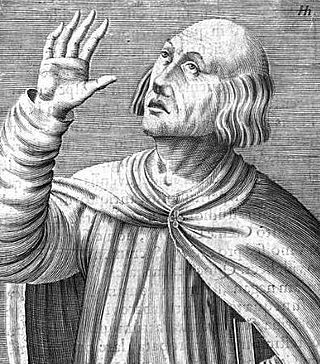
Berengar of Tours, in Latin Berengarius Turonensis, was an 11th-century French Christian theologian and archdeacon of Angers, a scholar whose leadership of the cathedral school at Chartres set an example of intellectual inquiry through the revived tools of dialectic that was soon followed at cathedral schools of Laon and Paris. Berengar of Tours was distinguished from mainline Catholic theology by two views: his assertion of the supremacy of Scripture and his denial of transubstantiation.
A common year starting on Sunday is any non-leap year that begins on Sunday, 1 January, and ends on Sunday, 31 December. Its dominical letter hence is A. The most recent year of such kind was 2023 and the next one will be 2034 in the Gregorian calendar, or, likewise, 2018 and 2029 in the obsolete Julian calendar, see below for more.
A common year starting on Monday is any non-leap year that begins on Monday, 1 January, and ends on Monday, 31 December. Its dominical letter hence is G. The most recent year of such kind was 2018 and the next one will be 2029 in the Gregorian calendar, or likewise, 2019 and 2030 in the Julian calendar, see below for more. This common year is one of the three possible common years in which a century year can begin on and occurs in century years that yield a remainder of 300 when divided by 400. The most recent such year was 1900 and the next one will be 2300.
"Cutting off one's nose to spite one's face" is an expression used to describe a needlessly self-destructive overreaction to a problem: "Don't cut off your nose to spite your face" is a warning against acting out of pique, or against pursuing revenge in a way that would damage oneself more than the object of one's anger.
A common year starting on Tuesday is any non-leap year that begins on Tuesday, 1 January, and ends on Tuesday, 31 December. Its dominical letter hence is F. The most recent year of such kind was 2019 and the next one will be 2030, or, likewise, 2014 and 2025 in the obsolete Julian calendar, see below for more.
A common year starting on Saturday is any non-leap year that begins on Saturday, 1 January, and ends on Saturday, 31 December. Its dominical letter hence is B. The most recent year of such kind was 2022 and the next one will be 2033 in the Gregorian calendar or, likewise, 2023 and 2034 in the obsolete Julian calendar. See below for more.

In the Latter Day Saint movement, an ordinance is a sacred rite or ceremony that has spiritual and symbolic meanings and act as a means of conveying divine grace. Ordinances are physical acts which signify or symbolize an underlying spiritual act; for some ordinances, the spiritual act is the finalization of a covenant between the ordinance recipient and God.

Foolishness for Christ refers to behavior such as giving up all one's worldly possessions upon joining an ascetic order or religious life, or deliberately flouting society's conventions to serve a religious purpose—particularly of Christianity. Such individuals have historically been known as both "holy fools" and "blessed fools". The term "fool" connotes what is perceived as feeblemindedness, and "blessed" or "holy" refers to innocence in the eyes of God.

The Basilica of Saint Francis of Assisi is the mother church of the Roman Catholic Order of Friars Minor Conventual in Assisi, a town in the Umbria region in central Italy, where Saint Francis was born and died. It is a papal minor basilica and one of the most important places of Christian pilgrimage in Italy. With its accompanying friary, Sacro Convento, the basilica is a distinctive landmark to those approaching Assisi. It has been a UNESCO World Heritage Site since 2000.
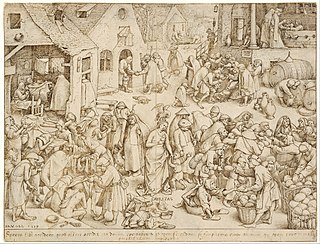
Works of mercy are practices considered meritorious in Christian ethics.

In Christian theology, the imitation of Christ is the practice of following the example of Jesus. In Eastern Christianity, the term life in Christ is sometimes used for the same concept.

The Mond Crucifixion or Gavari Altarpiece is an oil on poplar panel dated to 1502–1503, making it one of the earliest works by Italian Renaissance artist Raphael, perhaps the second after the c.1499-1500 Baronci Altarpiece. It originally comprised four elements, of which three survive, now all separated: a main panel of the Crucified Christ with the Virgin Mary, Saints and Angels which was bequeathed to the National Gallery, London, by Ludwig Mond, and a three-panel predella from which one panel is lost; the two surviving panels are Eusebius of Cremona raising Three Men from the Dead with Saint Jerome's Cloak in the Museu Nacional de Arte Antiga, in Lisbon, and Saint Jerome saving Silvanus and punishing the Heretic Sabinianus in the North Carolina Museum of Art.
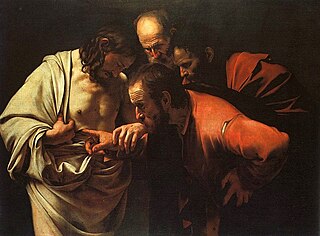
A number of people have claimed to have had visions of Jesus Christ and personal conversations with him. Some people make similar claims regarding his mother, Mary. Discussions about the authenticity of these visions have often invited controversy. The Catholic Church endorses a fraction of these claims, and various visionaries it accepts have achieved beatification, or even sainthood.

Thanksgiving after Communion is a spiritual practice among Christians who believe in the Real Presence of Jesus Christ in the Communion bread, maintaining themselves in prayer for some time to thank God and especially listening in their hearts for guidance from their Divine guest. This practice was and is highly recommended by saints, theologians, and Doctors of the Church.

Throughout history, Catholic Mariology has been influenced by a number of saints who have attested to the central role of Mary in God's plan of salvation. The analysis of Early Church Fathers continues to be reflected in modern encyclicals. Irenaeus vigorously defended the title of "Theotokos" or Mother of God. The views of Anthony of Padua, Robert Bellarmine and others supported the doctrine of the Immaculate Conception of the Virgin Mary, which was declared a dogma in 1850.
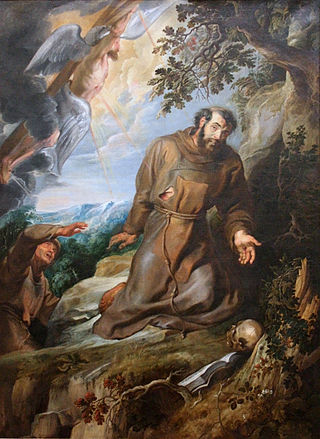
Saint Francis Receiving the Stigmata is an oil painting on canvas by Peter Paul Rubens, produced for the Franciscan monastic church in Ghent, probably part of a commission for three works for the same church – the others were St Mary Magdalene in Ecstasy and The Virgin Mary and Saint Francis Saving the World from Christ's Anger. It measures 265.5 cm x 193 cm and has been variously dated to around 1630 and to between 1615 and 1620.
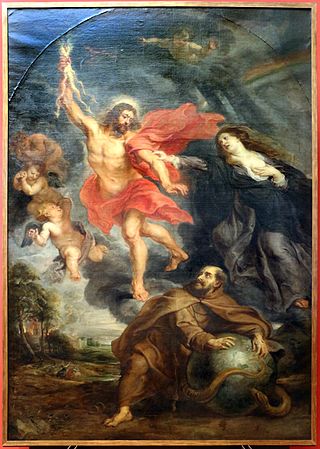
The Virgin Mary and Saint Francis Saving the World from Christ's Anger is a work by Peter Paul Rubens and his studio, created c. 1614. It is linked to his Saints Dominic and Francis Saving the World from Christ's Anger (Lyon). It is now in the Royal Museum of Fine Arts of Belgium in Brussels.

The Suardi Chapel is an oratory or private chapel inside the villa in Trescore Balneario, Province of Bergamo owned by the Suardi counts. It is dedicated to Saint Barbara and Saint Brigid and was completely rebuilt by the cousins Giovan Battista and Maffeo Suardi. It was fully covered in 1524 by frescoes commissioned by them from Lorenzo Lotto of Christ the Vine and Lives of the Saints. In the 19th century, count Gianforte Suardi built a corridor connecting the chapel to the villa and modified the chapel entrance – those entering had previously immediately found themselves in front of the north wall with its depiction of Christ the Vine.















